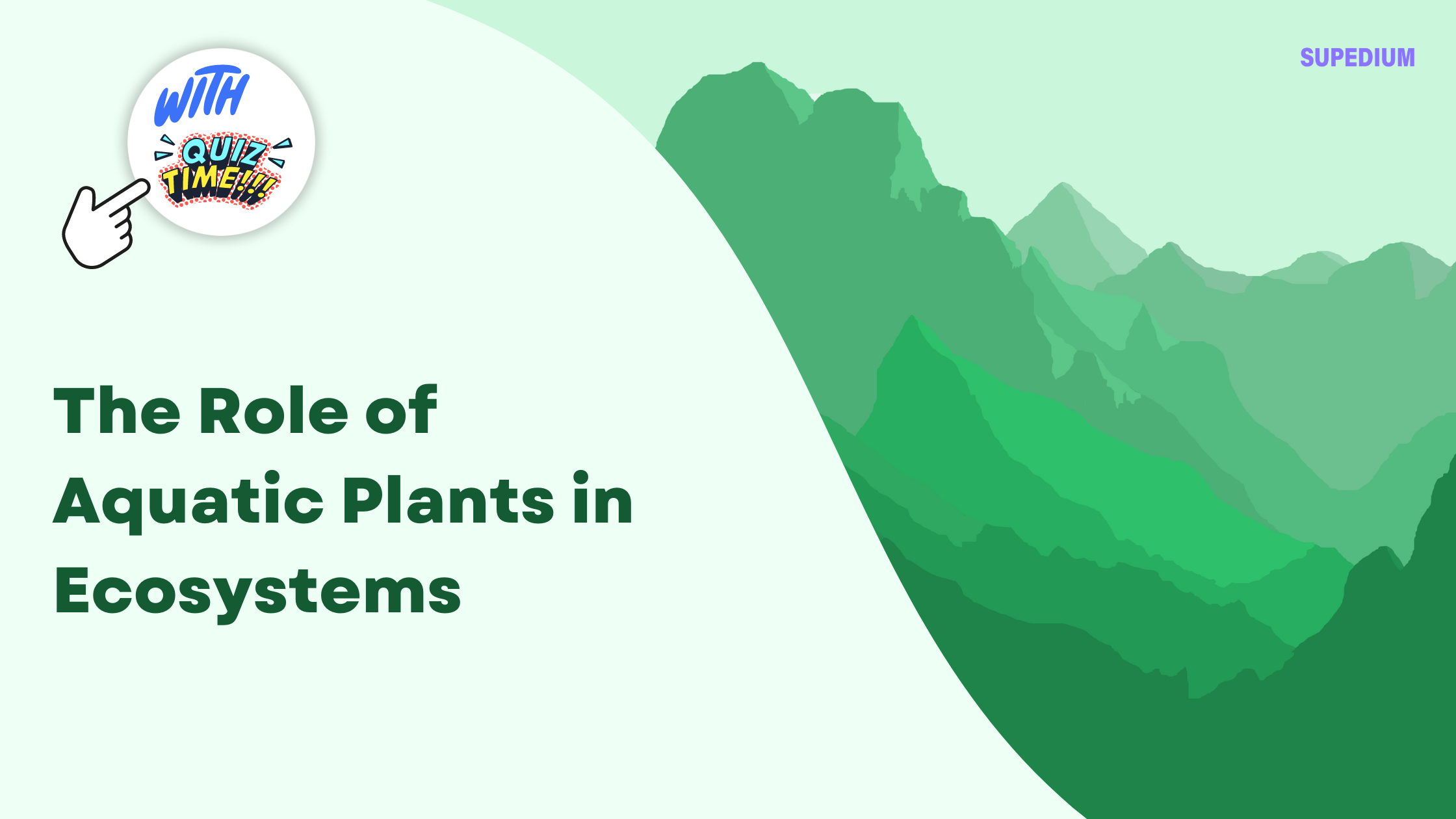Table of Contents
![]()
Introduction
Aquatic plants, which include a diverse range of species adapted to life in or near water, play a crucial role in maintaining the health and functionality of aquatic ecosystems. These plants can be categorized into three main types: emergent, floating, and submerged. Each type contributes uniquely to the ecological balance, impacting everything from water quality to habitat provision. This article explores the multifaceted roles of aquatic plants, their interactions with other ecosystem components, human influences, and future considerations.
Types of Aquatic Plants and Their Characteristics
Emergent Plants Emergent aquatic plants, such as cattails, bulrushes, and reeds, grow in shallow water with their roots anchored in the sediment and their stems rising above the water’s surface. These plants are characterized by their ability to tolerate fluctuating water levels and their adaptability to various water conditions. Their tall, sturdy stems and large leaves help stabilize the soil and provide critical habitat for many species of birds, insects, and amphibians.
Floating Plants Floating plants, including water lilies, duckweed, and water hyacinth, float on the water’s surface and do not anchor themselves in the sediment. Their leaves are adapted to capture sunlight efficiently, and their roots dangle in the water, often absorbing nutrients directly. These plants provide shade and reduce the growth of algae by limiting light penetration into the water. Floating plants also offer shelter and breeding grounds for aquatic organisms.
Submerged Plants Submerged aquatic plants, such as eelgrass, hornwort, and coontail, are fully submerged beneath the water’s surface. They are adapted to low light conditions and have flexible stems that can sway with water currents. Submerged plants play a critical role in oxygenating the water through photosynthesis, stabilizing sediments, and providing habitat and food for fish and invertebrates.
Ecological Roles of Aquatic Plants
Habitat and Shelter Aquatic plants create complex habitats that support a diverse array of organisms. Emergent plants provide nesting sites and cover for birds, while floating plants offer shelter and protection for fish and amphibians. Submerged plants serve as hiding spots and breeding areas for many aquatic species. The intricate root systems of these plants also create microhabitats for microorganisms, contributing to the overall biodiversity of aquatic ecosystems.
Water Quality Improvement Aquatic plants play a significant role in enhancing water quality. They absorb excess nutrients, such as nitrogen and phosphorus, from the water, which helps mitigate eutrophication—a process that can lead to algal blooms and oxygen depletion. By stabilizing sediments with their root systems, aquatic plants prevent erosion and reduce sedimentation, which can improve water clarity. Additionally, submerged plants contribute to oxygenation, which is essential for the survival of aerobic aquatic organisms.
Oxygen Production Through the process of photosynthesis, aquatic plants produce oxygen, which is vital for the survival of fish and other aerobic organisms. During daylight hours, submerged plants release oxygen into the water, helping to maintain appropriate oxygen levels in aquatic environments. This oxygenation is crucial for sustaining healthy aquatic ecosystems and supporting diverse biological communities.
Interactions with Other Ecosystem Components
Interactions with Aquatic Animals Aquatic plants have complex interactions with the animals in their ecosystems. For example, some fish and invertebrates depend on the physical structure of aquatic plants for protection and hunting grounds. Aquatic plants also form part of the food web; many herbivorous species feed directly on plant material, while others rely on the insects and microorganisms that inhabit the plants. These interactions highlight the interdependence of aquatic plants and animals in maintaining ecosystem balance.
Interactions with Microorganisms Aquatic plants influence nutrient cycling and microbial communities in aquatic ecosystems. Their roots release organic compounds into the sediment, providing a food source for microorganisms. In turn, these microbes decompose plant material and contribute to nutrient recycling. The presence of aquatic plants can also affect the composition of microbial communities, influencing processes such as nitrogen fixation and organic matter decomposition.
Aquatic Plants and Human Activities
Economic Importance Aquatic plants have various economic uses. In agriculture, rice paddies are a notable example where aquatic plants are cultivated. Additionally, some aquatic plants are harvested for ornamental purposes, such as in garden ponds and aquariums. Water hyacinth and duckweed have been explored for their potential in wastewater treatment and biofuel production, demonstrating their value in sustainable practices.
Recreational and Aesthetic Value Aquatic plants enhance the aesthetic and recreational value of water bodies. Their presence can improve the visual appeal of lakes, ponds, and rivers, attracting tourists and recreational users. Landscaping with aquatic plants can create visually pleasing and ecologically beneficial environments. Furthermore, activities such as boating, fishing, and bird-watching often rely on healthy aquatic plant communities to support the associated wildlife and habitats.
Management and Conservation Issues The management of aquatic plants can be challenging, especially when dealing with invasive species. Plants like water hyacinth and hydrilla can outcompete native species, disrupt ecosystems, and cause economic damage. Conservation efforts focus on controlling these invasive species and restoring native aquatic plant communities. Sustainable management practices, including careful monitoring and habitat restoration, are essential for maintaining the balance and health of aquatic ecosystems.
Case Studies
Examples of Aquatic Plant Ecosystems One notable example is the Everglades in Florida, a vast wetland where aquatic plants play a crucial role in shaping the landscape and supporting a diverse array of species. Another example is Lake Victoria, where aquatic plants are integral to the lake’s ecosystem, though challenges with invasive species have affected the balance of native plant and animal populations.
Impact of Human Activities Human activities, such as pollution and habitat destruction, have significant impacts on aquatic plant ecosystems. Pollution can lead to nutrient overloads and harmful algal blooms, while habitat destruction reduces the available space for aquatic plants to thrive. Restoration projects, such as replanting native species and improving water quality, aim to address these challenges and support ecosystem recovery.
Future Directions
Research and Monitoring Ongoing research is essential for understanding aquatic plant dynamics and improving ecosystem management. Advances in technology, such as remote sensing and genetic analysis, offer new tools for monitoring aquatic plant populations and assessing ecosystem health. Research into plant physiology and interactions with other species can provide insights into how aquatic plants respond to environmental changes and inform conservation strategies.
Climate Change and Aquatic Plants Climate change poses potential threats to aquatic plant ecosystems, including shifts in temperature, water levels, and nutrient availability. Adaptation strategies, such as selecting resilient plant species and implementing adaptive management practices, are necessary to ensure the continued health and functionality of these ecosystems. Understanding how climate change affects aquatic plants and their interactions with other ecosystem components is critical for developing effective conservation measures.
Conclusion
Aquatic plants are vital components of aquatic ecosystems, playing essential roles in habitat provision, water quality improvement, and oxygen production. Their interactions with other ecosystem components highlight their importance in maintaining ecological balance. Human activities have significant impacts on aquatic plant communities, necessitating careful management and conservation efforts. As we move forward, continued research and adaptive strategies will be crucial in preserving the health and sustainability of aquatic ecosystems in the face of changing environmental conditions.






Be the first to comment